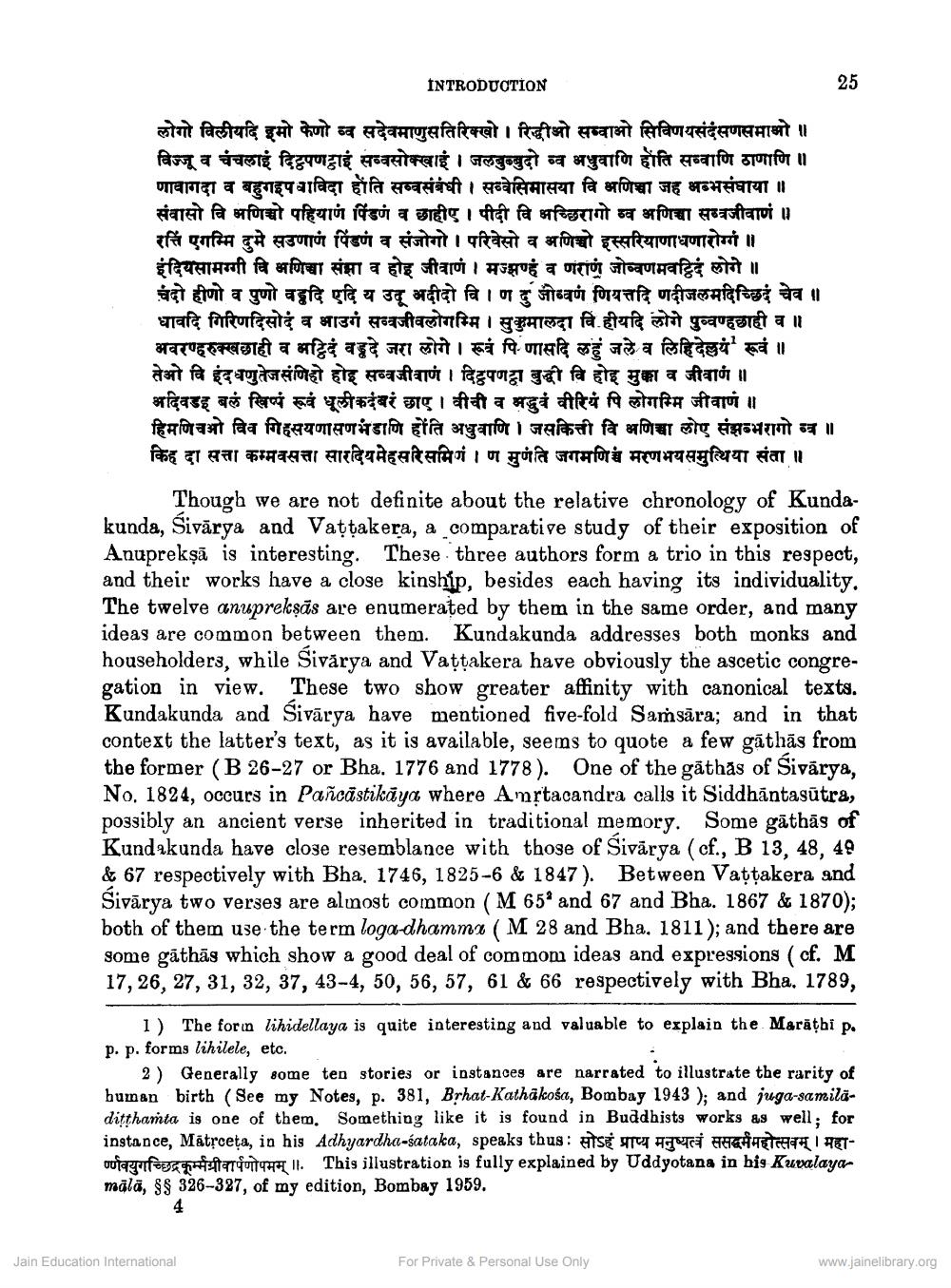________________
INTRODUCTION
25
लोगो विलीयदि इमो फेणो ब्व सदेवमाणुसतिरिक्खो। रिद्धीओ सम्वाओ सिविणयसंदसणसमाओ ॥ विज्ज व चंचलाई दिट्रपणदाई सब्वसोक्खाई। जलबब्बदो ब्व अधुवाणि होति सम्वाणि ठाणाणि ॥ णावागदा व बहुगइपबाविदा होति सव्वसंबंधी। सब्वेसिमासया वि अणिचा जह अब्भसंधाया ॥ संवासो चि भणिञ्चो पहियाणं पिंडणं व छाहीए। पीदी वि अच्छिरागो व्व अणिचा सम्धजीवाणं॥ रतिं एगम्मि दुमे सउणाणं पिंडणं व संजोगो । परिवेसो व अणिञ्चो इस्सरियाणाधणारोग्गं । इंदियसामग्गी वि अणिचा संझा व होइ जीवाणं । मज्झण्हं व णराणं जोवणमवट्ठिदं लोगे ॥ चंदो हीणो व पुणो वद्ददि एदि य उद् अदीदो वि। ण दुजोवण णियत्तदि णदीजलमदिच्छिदं चेव ॥ धावदि गिरिणदिसोदं व आउगं सबजीवलोगम्मि । सुकुमालदा वि.हीयदि लोगे पुन्वण्हछाही व ॥ अवरणहरुक्खछाही व मट्टिदं वड्डदे जरा लोगे । रूवं पिणासदि लहुं जले व लिहिदेल्लयंरूवं ॥ तेओ वि इंदधणुतेजसंणिहो होइ सव्वजीवाणं । दिट्ठपणट्ठा बुद्धी वि होइ मुक्का व जीवाणं ॥ अदिवडइ बलं खिप्पं रूवं धूलीकदंबरं छाए। वीची व भद्धवं वीरियं पिलोगम्मि जीवाणं ॥ हिमणिचो विव गिहसयणासणभंडाणि होति अधुवाणि । जसकित्ती वि अणिचा लोए संझन्भरागो च ॥ किह दा सत्ता कम्मवसत्ता सारदियमेहसरिसमिगं । ण मुणंति जगमणि मरणभयसमुत्थिया संता ॥
Though we are not definite about the relative chronology of Kundakunda, Sivārya and Vattakera, a comparative study of their exposition of Anupreksa is interesting. These . three authors form a trio in this respect, and their works have a close kinship, besides each having its individuality. The twelve anuprekşās are enumerated by them in the same order, and many ideas are common between them. Kundakunda addresses both monks and householders, while Sivărya and Vattakera have obviously the ascetic congregation in view. These two show greater affinity with canonical texts. Kundakunda and Sivārya have mentioned five-fold Samsāra; and in that context the latter's text, as it is available, seems to quote a few gāthās from the former (B26-27 or Bha. 1776 and 1778). One of the gathas of Sivarya, No. 1824, occurs in Pañcāstikaya where Amrtacandra calls it Siddhāntasūtra, possibly an ancient verse inherited in traditional memory. Some gāthās of Kundakunda have close resemblance with those of Sivārya (cf., B 13, 48, 49 & 67 respectively with Bha. 1746, 1825-6 & 1847). Between Vattakera and Sivārya two verses are alınost common (M 65 and 67 and Bha. 1867 & 1870); both of them use the term loga-dhamma (M 28 and Bha. 1811); and there are some gāthās which show a good deal of commom ideas and expressions (cf. M 17, 26, 27, 31, 32, 37, 43-4, 50, 56, 57, 61 & 66 respectively with Bha. 1789,
1) The forin lihidellaya is quite interesting and valuable to explain the Marāthi p. p. p. forms lihilele, etc.
2) Generally some ten stories or instances are narrated to illustrate the rarity of human birth (See my Notes, p. 381, Brhat-Kathakośa, Bombay 1943 ); and juga-samiladitthanta is one of them. Something like it is found in Buddhists works as well; for instance, Matreeta, in his Adhyardha-sataka, speaks thus : सोऽहं प्राप्य मनुष्यत्वं ससद्धर्ममहोत्सवम् । महा
र्णवयुगच्छिद्रकूर्मग्रीवार्पणोपमम् ।।. This illustration is fully explained by Uddyotana in his Kuvalayamālā, $ 326-327, of my edition, Bombay 1959.
Jain Education International
For Private & Personal Use Only
www.jainelibrary.org




